Hospitality Business Toolkit: Financial, HR, and Legal Report
VerifiedAdded on 2023/01/13
|12
|3334
|42
Report
AI Summary
This report analyzes key aspects of the hospitality business, using East London Catering as a case study. It investigates financial performance through techniques like financial statement preparation, aged debtors analysis, and ratio calculations. The report also examines the HR life cycle, focusing on recruitment, education, motivation, evaluation, and celebration to enhance talent development and retention. Furthermore, it provides a performance management plan to address negative behaviors among employees. Finally, it identifies relevant legislation and legal considerations impacting hospitality businesses, including employment and contract law, emphasizing the importance of compliance and its effect on decision-making within the sector. The report provides a comprehensive overview of managing financial, human resources, and legal aspects within the hospitality industry.
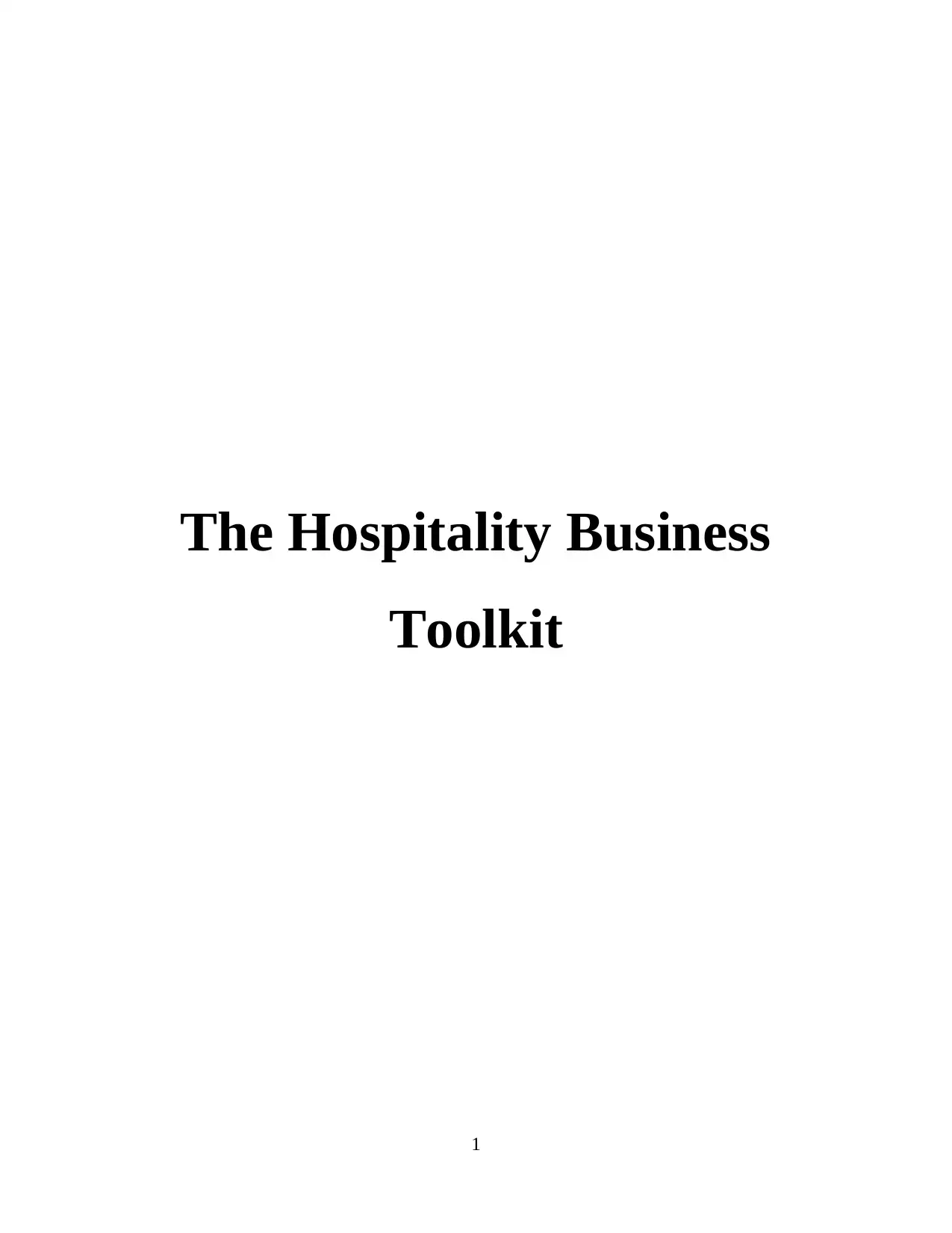
The Hospitality Business
Toolkit
1
Toolkit
1
Paraphrase This Document
Need a fresh take? Get an instant paraphrase of this document with our AI Paraphraser
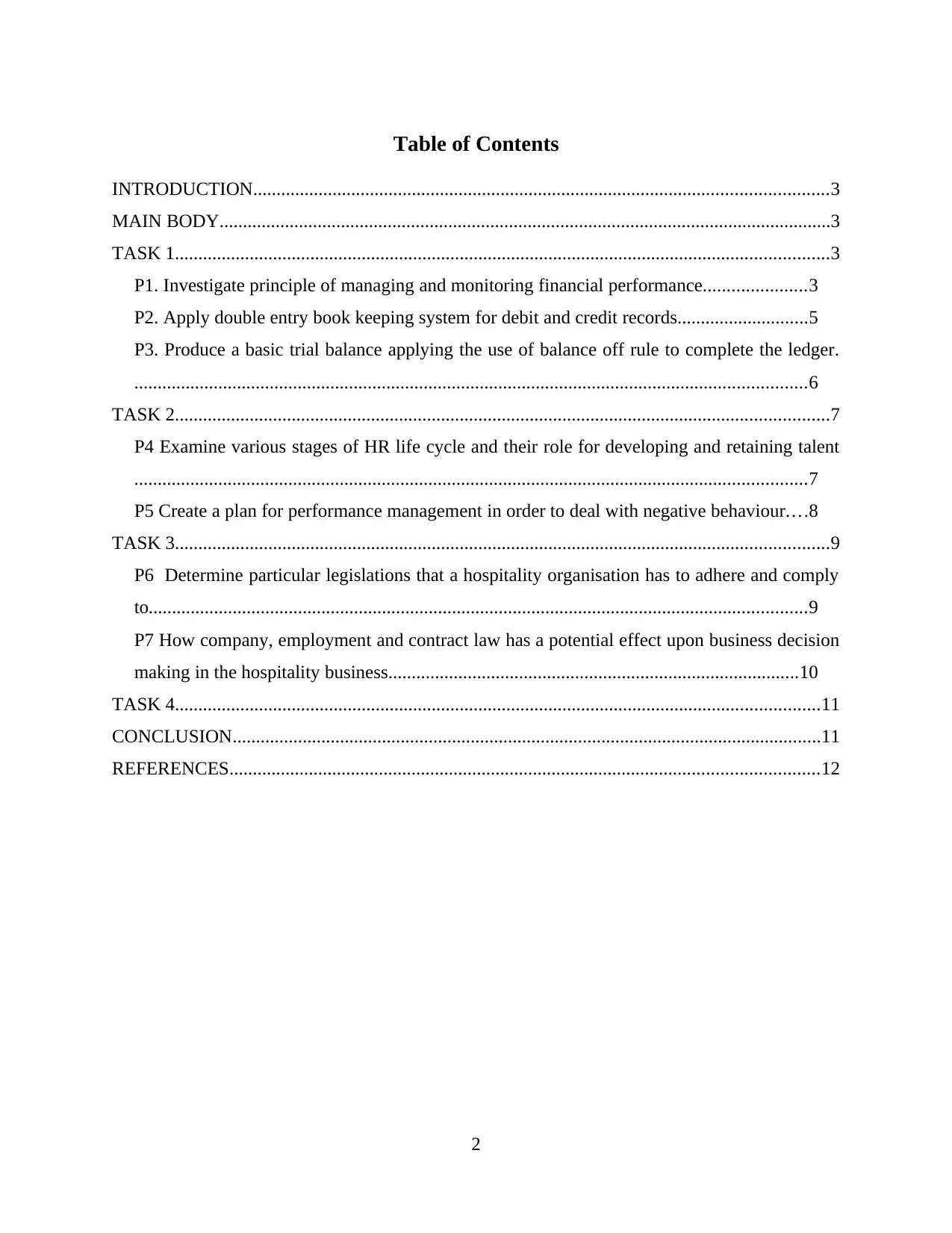
Table of Contents
INTRODUCTION...........................................................................................................................3
MAIN BODY...................................................................................................................................3
TASK 1............................................................................................................................................3
P1. Investigate principle of managing and monitoring financial performance......................3
P2. Apply double entry book keeping system for debit and credit records............................5
P3. Produce a basic trial balance applying the use of balance off rule to complete the ledger.
................................................................................................................................................6
TASK 2............................................................................................................................................7
P4 Examine various stages of HR life cycle and their role for developing and retaining talent
................................................................................................................................................7
P5 Create a plan for performance management in order to deal with negative behaviour....8
TASK 3............................................................................................................................................9
P6 Determine particular legislations that a hospitality organisation has to adhere and comply
to.............................................................................................................................................9
P7 How company, employment and contract law has a potential effect upon business decision
making in the hospitality business........................................................................................10
TASK 4..........................................................................................................................................11
CONCLUSION..............................................................................................................................11
REFERENCES..............................................................................................................................12
2
INTRODUCTION...........................................................................................................................3
MAIN BODY...................................................................................................................................3
TASK 1............................................................................................................................................3
P1. Investigate principle of managing and monitoring financial performance......................3
P2. Apply double entry book keeping system for debit and credit records............................5
P3. Produce a basic trial balance applying the use of balance off rule to complete the ledger.
................................................................................................................................................6
TASK 2............................................................................................................................................7
P4 Examine various stages of HR life cycle and their role for developing and retaining talent
................................................................................................................................................7
P5 Create a plan for performance management in order to deal with negative behaviour....8
TASK 3............................................................................................................................................9
P6 Determine particular legislations that a hospitality organisation has to adhere and comply
to.............................................................................................................................................9
P7 How company, employment and contract law has a potential effect upon business decision
making in the hospitality business........................................................................................10
TASK 4..........................................................................................................................................11
CONCLUSION..............................................................................................................................11
REFERENCES..............................................................................................................................12
2
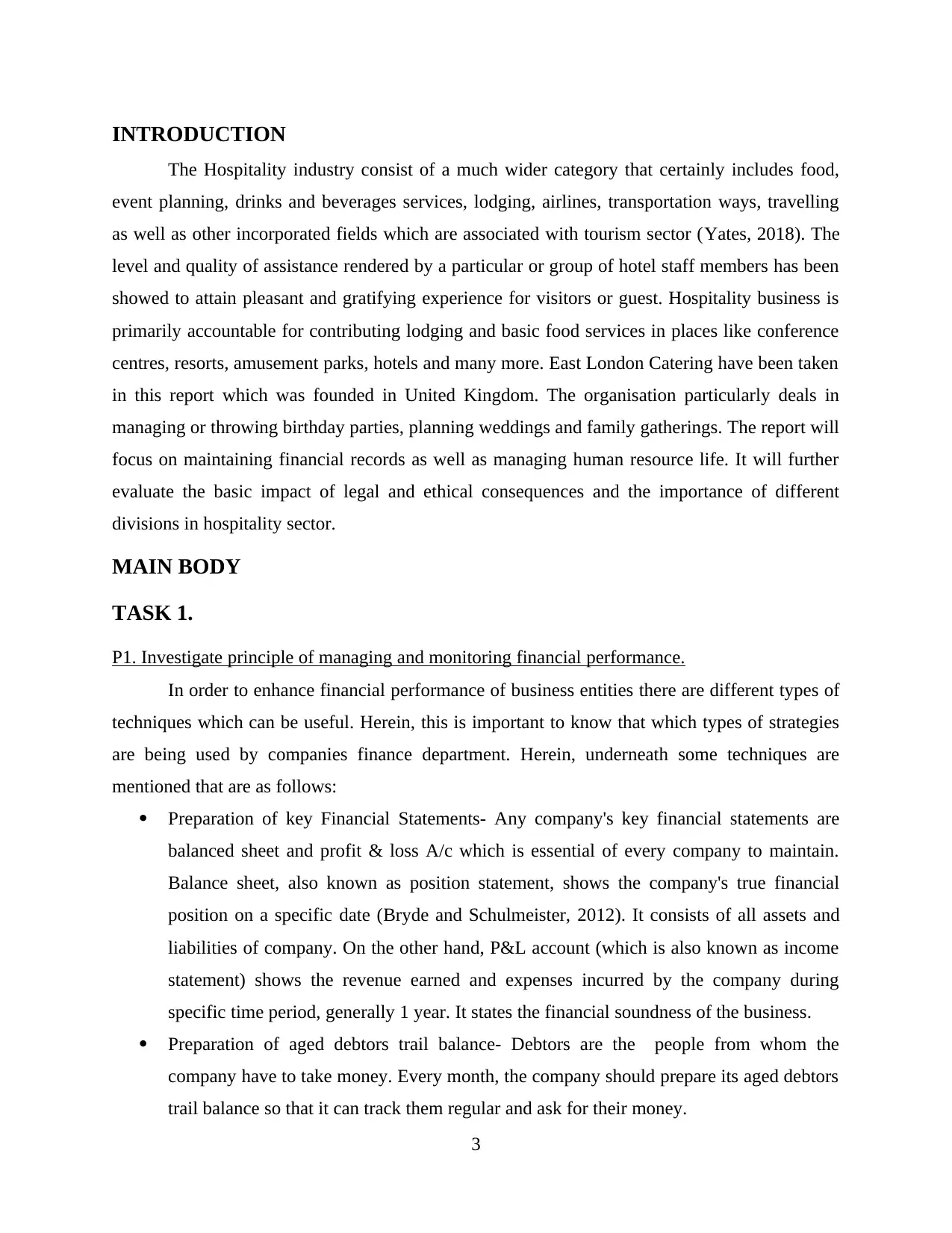
INTRODUCTION
The Hospitality industry consist of a much wider category that certainly includes food,
event planning, drinks and beverages services, lodging, airlines, transportation ways, travelling
as well as other incorporated fields which are associated with tourism sector (Yates, 2018). The
level and quality of assistance rendered by a particular or group of hotel staff members has been
showed to attain pleasant and gratifying experience for visitors or guest. Hospitality business is
primarily accountable for contributing lodging and basic food services in places like conference
centres, resorts, amusement parks, hotels and many more. East London Catering have been taken
in this report which was founded in United Kingdom. The organisation particularly deals in
managing or throwing birthday parties, planning weddings and family gatherings. The report will
focus on maintaining financial records as well as managing human resource life. It will further
evaluate the basic impact of legal and ethical consequences and the importance of different
divisions in hospitality sector.
MAIN BODY
TASK 1.
P1. Investigate principle of managing and monitoring financial performance.
In order to enhance financial performance of business entities there are different types of
techniques which can be useful. Herein, this is important to know that which types of strategies
are being used by companies finance department. Herein, underneath some techniques are
mentioned that are as follows:
Preparation of key Financial Statements- Any company's key financial statements are
balanced sheet and profit & loss A/c which is essential of every company to maintain.
Balance sheet, also known as position statement, shows the company's true financial
position on a specific date (Bryde and Schulmeister, 2012). It consists of all assets and
liabilities of company. On the other hand, P&L account (which is also known as income
statement) shows the revenue earned and expenses incurred by the company during
specific time period, generally 1 year. It states the financial soundness of the business.
Preparation of aged debtors trail balance- Debtors are the people from whom the
company have to take money. Every month, the company should prepare its aged debtors
trail balance so that it can track them regular and ask for their money.
3
The Hospitality industry consist of a much wider category that certainly includes food,
event planning, drinks and beverages services, lodging, airlines, transportation ways, travelling
as well as other incorporated fields which are associated with tourism sector (Yates, 2018). The
level and quality of assistance rendered by a particular or group of hotel staff members has been
showed to attain pleasant and gratifying experience for visitors or guest. Hospitality business is
primarily accountable for contributing lodging and basic food services in places like conference
centres, resorts, amusement parks, hotels and many more. East London Catering have been taken
in this report which was founded in United Kingdom. The organisation particularly deals in
managing or throwing birthday parties, planning weddings and family gatherings. The report will
focus on maintaining financial records as well as managing human resource life. It will further
evaluate the basic impact of legal and ethical consequences and the importance of different
divisions in hospitality sector.
MAIN BODY
TASK 1.
P1. Investigate principle of managing and monitoring financial performance.
In order to enhance financial performance of business entities there are different types of
techniques which can be useful. Herein, this is important to know that which types of strategies
are being used by companies finance department. Herein, underneath some techniques are
mentioned that are as follows:
Preparation of key Financial Statements- Any company's key financial statements are
balanced sheet and profit & loss A/c which is essential of every company to maintain.
Balance sheet, also known as position statement, shows the company's true financial
position on a specific date (Bryde and Schulmeister, 2012). It consists of all assets and
liabilities of company. On the other hand, P&L account (which is also known as income
statement) shows the revenue earned and expenses incurred by the company during
specific time period, generally 1 year. It states the financial soundness of the business.
Preparation of aged debtors trail balance- Debtors are the people from whom the
company have to take money. Every month, the company should prepare its aged debtors
trail balance so that it can track them regular and ask for their money.
3
⊘ This is a preview!⊘
Do you want full access?
Subscribe today to unlock all pages.

Trusted by 1+ million students worldwide
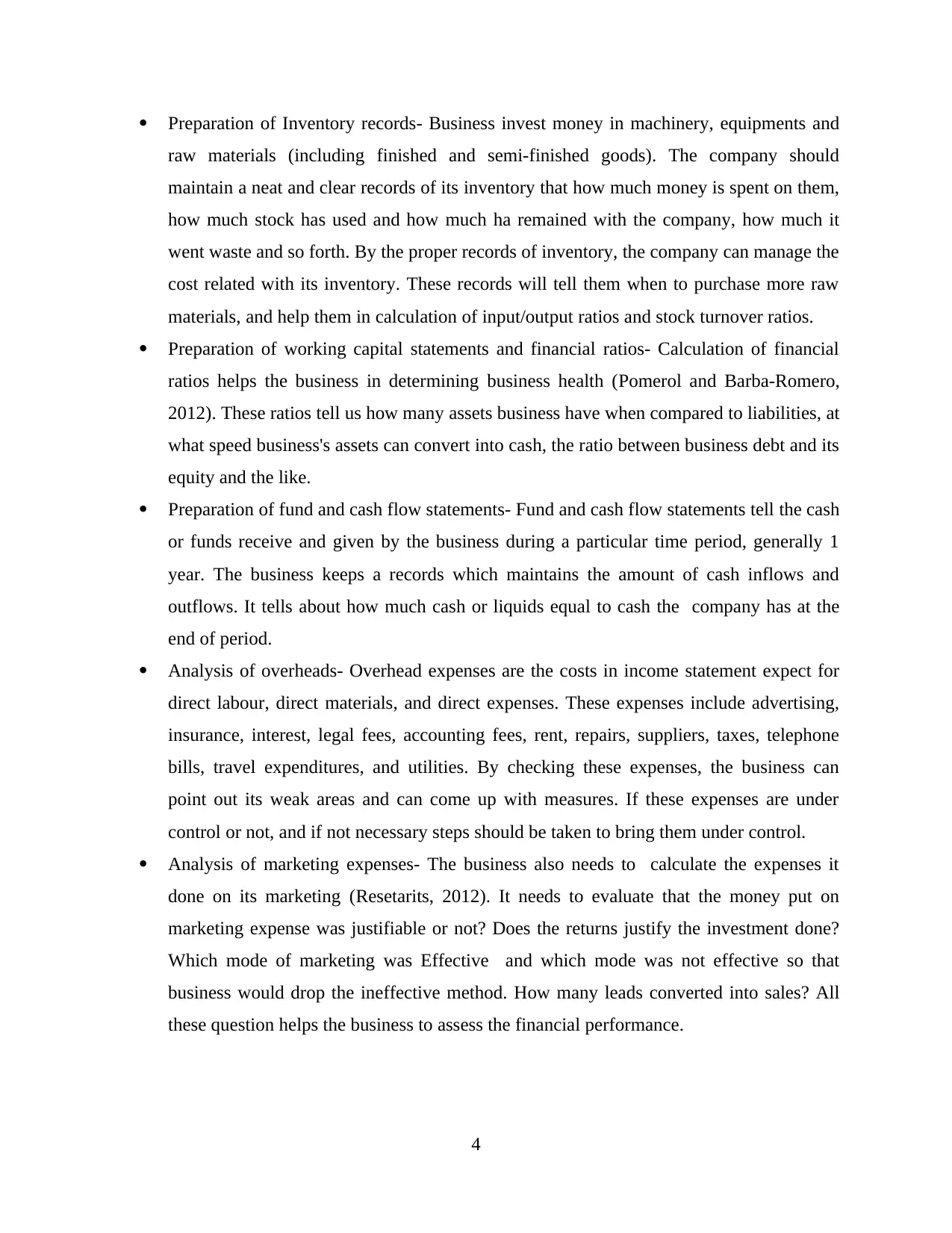
Preparation of Inventory records- Business invest money in machinery, equipments and
raw materials (including finished and semi-finished goods). The company should
maintain a neat and clear records of its inventory that how much money is spent on them,
how much stock has used and how much ha remained with the company, how much it
went waste and so forth. By the proper records of inventory, the company can manage the
cost related with its inventory. These records will tell them when to purchase more raw
materials, and help them in calculation of input/output ratios and stock turnover ratios.
Preparation of working capital statements and financial ratios- Calculation of financial
ratios helps the business in determining business health (Pomerol and Barba-Romero,
2012). These ratios tell us how many assets business have when compared to liabilities, at
what speed business's assets can convert into cash, the ratio between business debt and its
equity and the like.
Preparation of fund and cash flow statements- Fund and cash flow statements tell the cash
or funds receive and given by the business during a particular time period, generally 1
year. The business keeps a records which maintains the amount of cash inflows and
outflows. It tells about how much cash or liquids equal to cash the company has at the
end of period.
Analysis of overheads- Overhead expenses are the costs in income statement expect for
direct labour, direct materials, and direct expenses. These expenses include advertising,
insurance, interest, legal fees, accounting fees, rent, repairs, suppliers, taxes, telephone
bills, travel expenditures, and utilities. By checking these expenses, the business can
point out its weak areas and can come up with measures. If these expenses are under
control or not, and if not necessary steps should be taken to bring them under control.
Analysis of marketing expenses- The business also needs to calculate the expenses it
done on its marketing (Resetarits, 2012). It needs to evaluate that the money put on
marketing expense was justifiable or not? Does the returns justify the investment done?
Which mode of marketing was Effective and which mode was not effective so that
business would drop the ineffective method. How many leads converted into sales? All
these question helps the business to assess the financial performance.
4
raw materials (including finished and semi-finished goods). The company should
maintain a neat and clear records of its inventory that how much money is spent on them,
how much stock has used and how much ha remained with the company, how much it
went waste and so forth. By the proper records of inventory, the company can manage the
cost related with its inventory. These records will tell them when to purchase more raw
materials, and help them in calculation of input/output ratios and stock turnover ratios.
Preparation of working capital statements and financial ratios- Calculation of financial
ratios helps the business in determining business health (Pomerol and Barba-Romero,
2012). These ratios tell us how many assets business have when compared to liabilities, at
what speed business's assets can convert into cash, the ratio between business debt and its
equity and the like.
Preparation of fund and cash flow statements- Fund and cash flow statements tell the cash
or funds receive and given by the business during a particular time period, generally 1
year. The business keeps a records which maintains the amount of cash inflows and
outflows. It tells about how much cash or liquids equal to cash the company has at the
end of period.
Analysis of overheads- Overhead expenses are the costs in income statement expect for
direct labour, direct materials, and direct expenses. These expenses include advertising,
insurance, interest, legal fees, accounting fees, rent, repairs, suppliers, taxes, telephone
bills, travel expenditures, and utilities. By checking these expenses, the business can
point out its weak areas and can come up with measures. If these expenses are under
control or not, and if not necessary steps should be taken to bring them under control.
Analysis of marketing expenses- The business also needs to calculate the expenses it
done on its marketing (Resetarits, 2012). It needs to evaluate that the money put on
marketing expense was justifiable or not? Does the returns justify the investment done?
Which mode of marketing was Effective and which mode was not effective so that
business would drop the ineffective method. How many leads converted into sales? All
these question helps the business to assess the financial performance.
4
Paraphrase This Document
Need a fresh take? Get an instant paraphrase of this document with our AI Paraphraser
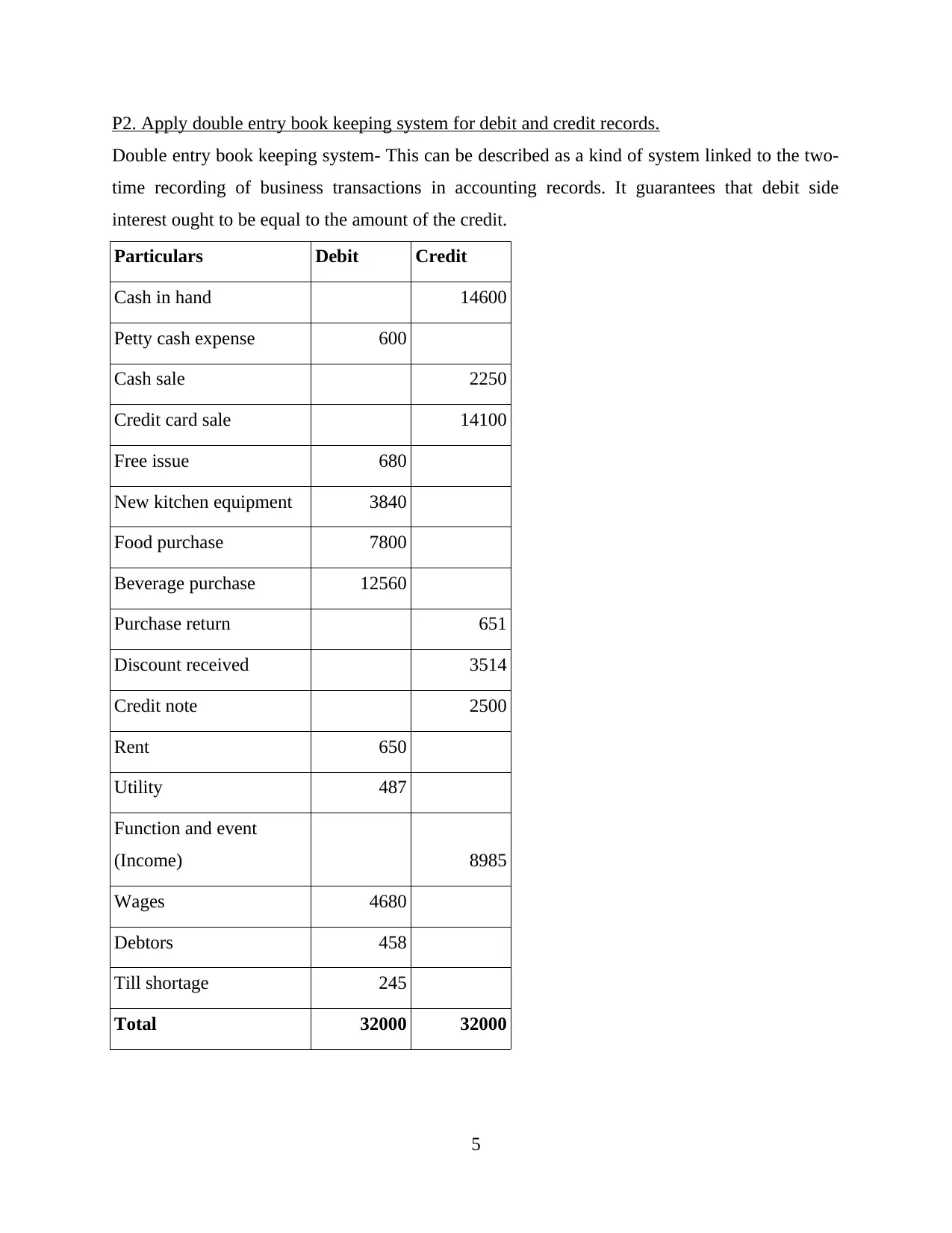
P2. Apply double entry book keeping system for debit and credit records.
Double entry book keeping system- This can be described as a kind of system linked to the two-
time recording of business transactions in accounting records. It guarantees that debit side
interest ought to be equal to the amount of the credit.
Particulars Debit Credit
Cash in hand 14600
Petty cash expense 600
Cash sale 2250
Credit card sale 14100
Free issue 680
New kitchen equipment 3840
Food purchase 7800
Beverage purchase 12560
Purchase return 651
Discount received 3514
Credit note 2500
Rent 650
Utility 487
Function and event
(Income) 8985
Wages 4680
Debtors 458
Till shortage 245
Total 32000 32000
5
Double entry book keeping system- This can be described as a kind of system linked to the two-
time recording of business transactions in accounting records. It guarantees that debit side
interest ought to be equal to the amount of the credit.
Particulars Debit Credit
Cash in hand 14600
Petty cash expense 600
Cash sale 2250
Credit card sale 14100
Free issue 680
New kitchen equipment 3840
Food purchase 7800
Beverage purchase 12560
Purchase return 651
Discount received 3514
Credit note 2500
Rent 650
Utility 487
Function and event
(Income) 8985
Wages 4680
Debtors 458
Till shortage 245
Total 32000 32000
5
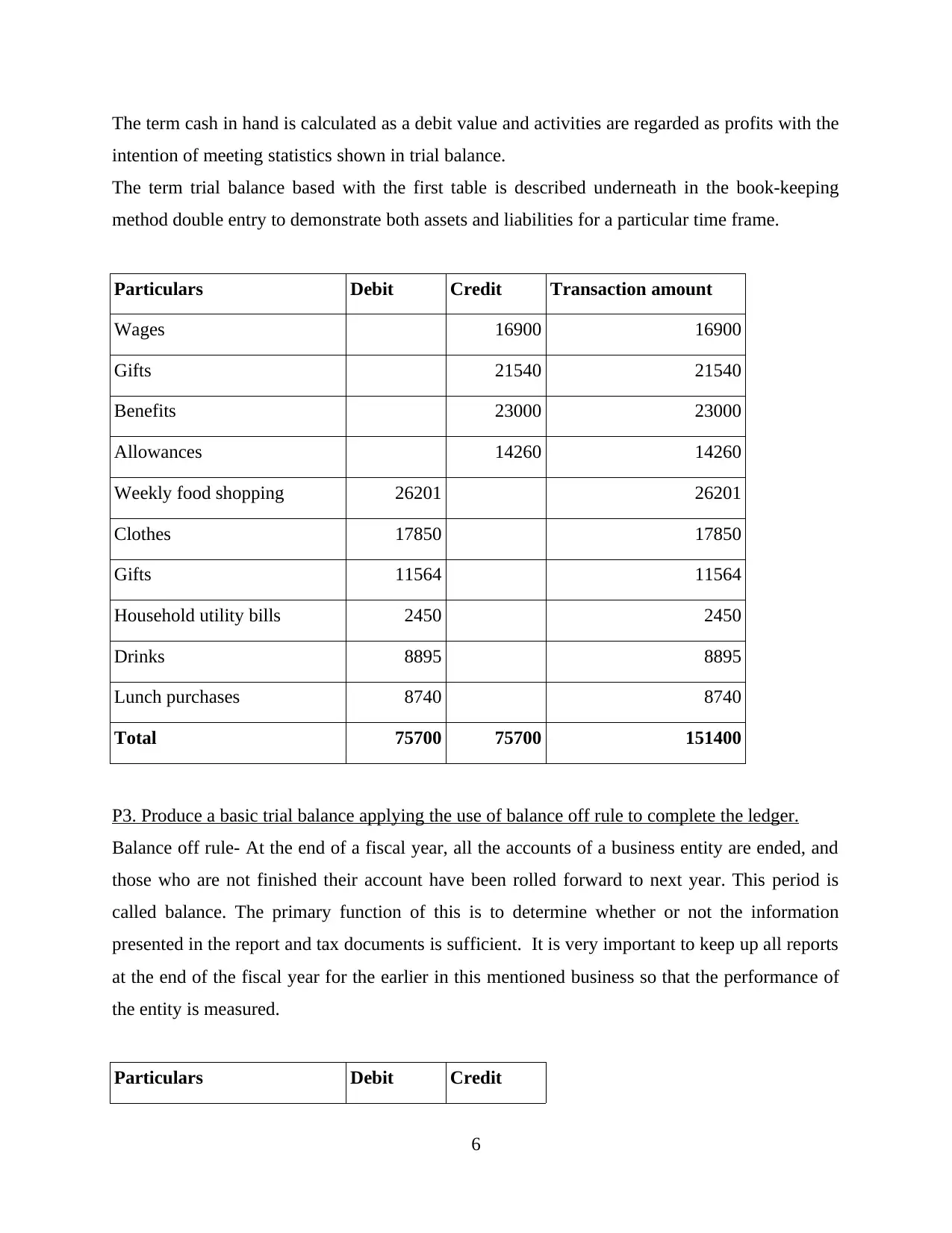
The term cash in hand is calculated as a debit value and activities are regarded as profits with the
intention of meeting statistics shown in trial balance.
The term trial balance based with the first table is described underneath in the book-keeping
method double entry to demonstrate both assets and liabilities for a particular time frame.
Particulars Debit Credit Transaction amount
Wages 16900 16900
Gifts 21540 21540
Benefits 23000 23000
Allowances 14260 14260
Weekly food shopping 26201 26201
Clothes 17850 17850
Gifts 11564 11564
Household utility bills 2450 2450
Drinks 8895 8895
Lunch purchases 8740 8740
Total 75700 75700 151400
P3. Produce a basic trial balance applying the use of balance off rule to complete the ledger.
Balance off rule- At the end of a fiscal year, all the accounts of a business entity are ended, and
those who are not finished their account have been rolled forward to next year. This period is
called balance. The primary function of this is to determine whether or not the information
presented in the report and tax documents is sufficient. It is very important to keep up all reports
at the end of the fiscal year for the earlier in this mentioned business so that the performance of
the entity is measured.
Particulars Debit Credit
6
intention of meeting statistics shown in trial balance.
The term trial balance based with the first table is described underneath in the book-keeping
method double entry to demonstrate both assets and liabilities for a particular time frame.
Particulars Debit Credit Transaction amount
Wages 16900 16900
Gifts 21540 21540
Benefits 23000 23000
Allowances 14260 14260
Weekly food shopping 26201 26201
Clothes 17850 17850
Gifts 11564 11564
Household utility bills 2450 2450
Drinks 8895 8895
Lunch purchases 8740 8740
Total 75700 75700 151400
P3. Produce a basic trial balance applying the use of balance off rule to complete the ledger.
Balance off rule- At the end of a fiscal year, all the accounts of a business entity are ended, and
those who are not finished their account have been rolled forward to next year. This period is
called balance. The primary function of this is to determine whether or not the information
presented in the report and tax documents is sufficient. It is very important to keep up all reports
at the end of the fiscal year for the earlier in this mentioned business so that the performance of
the entity is measured.
Particulars Debit Credit
6
⊘ This is a preview!⊘
Do you want full access?
Subscribe today to unlock all pages.

Trusted by 1+ million students worldwide
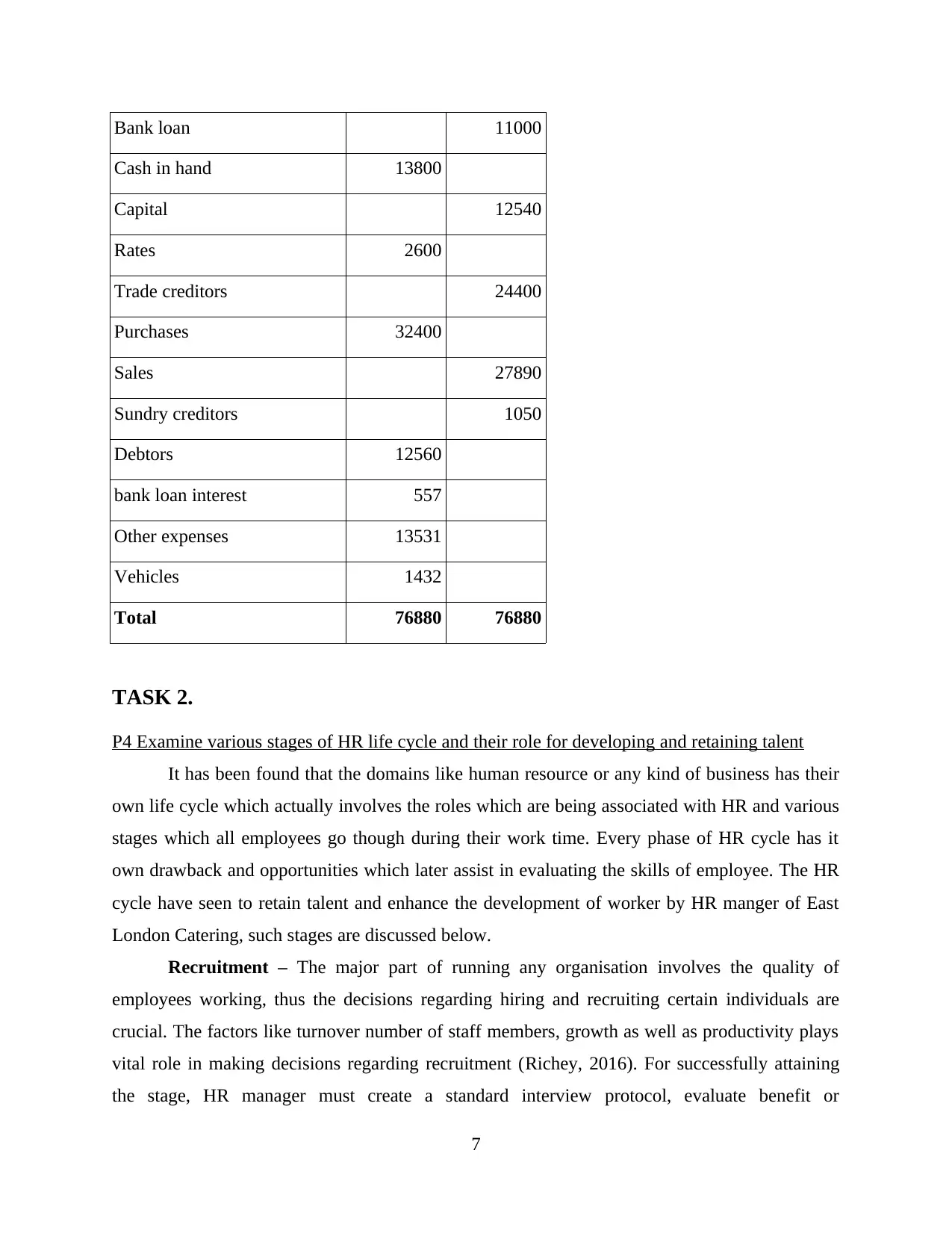
Bank loan 11000
Cash in hand 13800
Capital 12540
Rates 2600
Trade creditors 24400
Purchases 32400
Sales 27890
Sundry creditors 1050
Debtors 12560
bank loan interest 557
Other expenses 13531
Vehicles 1432
Total 76880 76880
TASK 2.
P4 Examine various stages of HR life cycle and their role for developing and retaining talent
It has been found that the domains like human resource or any kind of business has their
own life cycle which actually involves the roles which are being associated with HR and various
stages which all employees go though during their work time. Every phase of HR cycle has it
own drawback and opportunities which later assist in evaluating the skills of employee. The HR
cycle have seen to retain talent and enhance the development of worker by HR manger of East
London Catering, such stages are discussed below.
Recruitment – The major part of running any organisation involves the quality of
employees working, thus the decisions regarding hiring and recruiting certain individuals are
crucial. The factors like turnover number of staff members, growth as well as productivity plays
vital role in making decisions regarding recruitment (Richey, 2016). For successfully attaining
the stage, HR manager must create a standard interview protocol, evaluate benefit or
7
Cash in hand 13800
Capital 12540
Rates 2600
Trade creditors 24400
Purchases 32400
Sales 27890
Sundry creditors 1050
Debtors 12560
bank loan interest 557
Other expenses 13531
Vehicles 1432
Total 76880 76880
TASK 2.
P4 Examine various stages of HR life cycle and their role for developing and retaining talent
It has been found that the domains like human resource or any kind of business has their
own life cycle which actually involves the roles which are being associated with HR and various
stages which all employees go though during their work time. Every phase of HR cycle has it
own drawback and opportunities which later assist in evaluating the skills of employee. The HR
cycle have seen to retain talent and enhance the development of worker by HR manger of East
London Catering, such stages are discussed below.
Recruitment – The major part of running any organisation involves the quality of
employees working, thus the decisions regarding hiring and recruiting certain individuals are
crucial. The factors like turnover number of staff members, growth as well as productivity plays
vital role in making decisions regarding recruitment (Richey, 2016). For successfully attaining
the stage, HR manager must create a standard interview protocol, evaluate benefit or
7
Paraphrase This Document
Need a fresh take? Get an instant paraphrase of this document with our AI Paraphraser
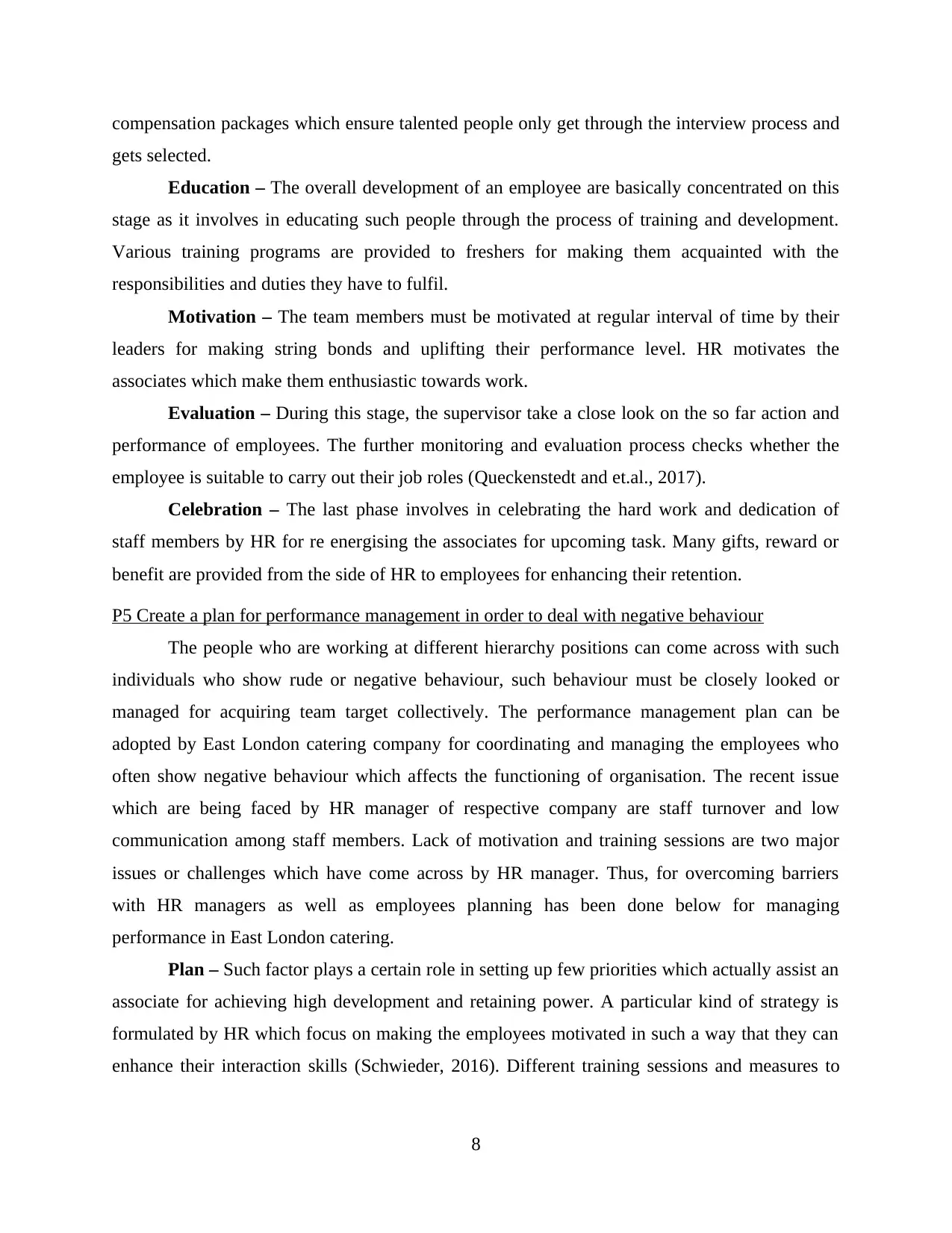
compensation packages which ensure talented people only get through the interview process and
gets selected.
Education – The overall development of an employee are basically concentrated on this
stage as it involves in educating such people through the process of training and development.
Various training programs are provided to freshers for making them acquainted with the
responsibilities and duties they have to fulfil.
Motivation – The team members must be motivated at regular interval of time by their
leaders for making string bonds and uplifting their performance level. HR motivates the
associates which make them enthusiastic towards work.
Evaluation – During this stage, the supervisor take a close look on the so far action and
performance of employees. The further monitoring and evaluation process checks whether the
employee is suitable to carry out their job roles (Queckenstedt and et.al., 2017).
Celebration – The last phase involves in celebrating the hard work and dedication of
staff members by HR for re energising the associates for upcoming task. Many gifts, reward or
benefit are provided from the side of HR to employees for enhancing their retention.
P5 Create a plan for performance management in order to deal with negative behaviour
The people who are working at different hierarchy positions can come across with such
individuals who show rude or negative behaviour, such behaviour must be closely looked or
managed for acquiring team target collectively. The performance management plan can be
adopted by East London catering company for coordinating and managing the employees who
often show negative behaviour which affects the functioning of organisation. The recent issue
which are being faced by HR manager of respective company are staff turnover and low
communication among staff members. Lack of motivation and training sessions are two major
issues or challenges which have come across by HR manager. Thus, for overcoming barriers
with HR managers as well as employees planning has been done below for managing
performance in East London catering.
Plan – Such factor plays a certain role in setting up few priorities which actually assist an
associate for achieving high development and retaining power. A particular kind of strategy is
formulated by HR which focus on making the employees motivated in such a way that they can
enhance their interaction skills (Schwieder, 2016). Different training sessions and measures to
8
gets selected.
Education – The overall development of an employee are basically concentrated on this
stage as it involves in educating such people through the process of training and development.
Various training programs are provided to freshers for making them acquainted with the
responsibilities and duties they have to fulfil.
Motivation – The team members must be motivated at regular interval of time by their
leaders for making string bonds and uplifting their performance level. HR motivates the
associates which make them enthusiastic towards work.
Evaluation – During this stage, the supervisor take a close look on the so far action and
performance of employees. The further monitoring and evaluation process checks whether the
employee is suitable to carry out their job roles (Queckenstedt and et.al., 2017).
Celebration – The last phase involves in celebrating the hard work and dedication of
staff members by HR for re energising the associates for upcoming task. Many gifts, reward or
benefit are provided from the side of HR to employees for enhancing their retention.
P5 Create a plan for performance management in order to deal with negative behaviour
The people who are working at different hierarchy positions can come across with such
individuals who show rude or negative behaviour, such behaviour must be closely looked or
managed for acquiring team target collectively. The performance management plan can be
adopted by East London catering company for coordinating and managing the employees who
often show negative behaviour which affects the functioning of organisation. The recent issue
which are being faced by HR manager of respective company are staff turnover and low
communication among staff members. Lack of motivation and training sessions are two major
issues or challenges which have come across by HR manager. Thus, for overcoming barriers
with HR managers as well as employees planning has been done below for managing
performance in East London catering.
Plan – Such factor plays a certain role in setting up few priorities which actually assist an
associate for achieving high development and retaining power. A particular kind of strategy is
formulated by HR which focus on making the employees motivated in such a way that they can
enhance their interaction skills (Schwieder, 2016). Different training sessions and measures to
8
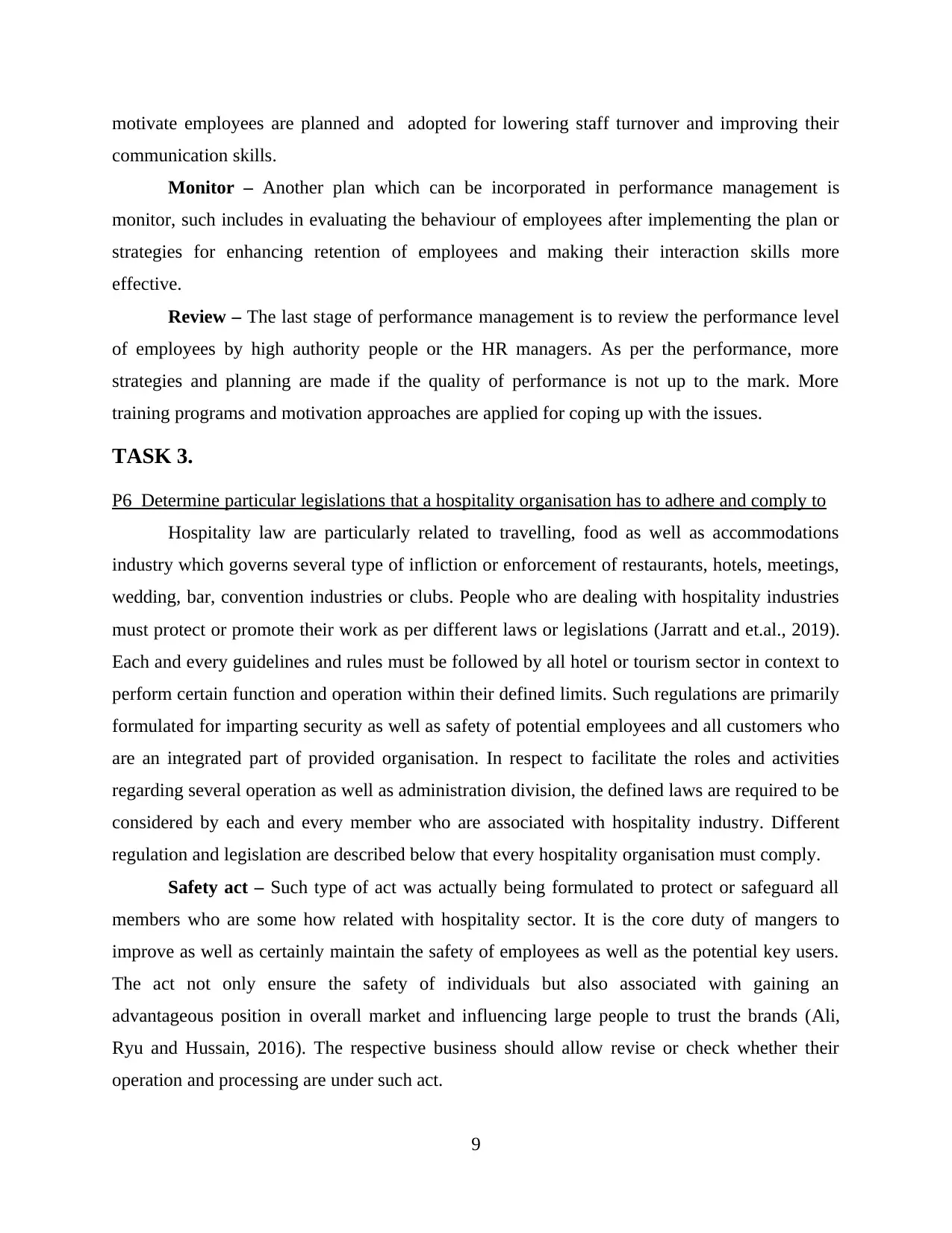
motivate employees are planned and adopted for lowering staff turnover and improving their
communication skills.
Monitor – Another plan which can be incorporated in performance management is
monitor, such includes in evaluating the behaviour of employees after implementing the plan or
strategies for enhancing retention of employees and making their interaction skills more
effective.
Review – The last stage of performance management is to review the performance level
of employees by high authority people or the HR managers. As per the performance, more
strategies and planning are made if the quality of performance is not up to the mark. More
training programs and motivation approaches are applied for coping up with the issues.
TASK 3.
P6 Determine particular legislations that a hospitality organisation has to adhere and comply to
Hospitality law are particularly related to travelling, food as well as accommodations
industry which governs several type of infliction or enforcement of restaurants, hotels, meetings,
wedding, bar, convention industries or clubs. People who are dealing with hospitality industries
must protect or promote their work as per different laws or legislations (Jarratt and et.al., 2019).
Each and every guidelines and rules must be followed by all hotel or tourism sector in context to
perform certain function and operation within their defined limits. Such regulations are primarily
formulated for imparting security as well as safety of potential employees and all customers who
are an integrated part of provided organisation. In respect to facilitate the roles and activities
regarding several operation as well as administration division, the defined laws are required to be
considered by each and every member who are associated with hospitality industry. Different
regulation and legislation are described below that every hospitality organisation must comply.
Safety act – Such type of act was actually being formulated to protect or safeguard all
members who are some how related with hospitality sector. It is the core duty of mangers to
improve as well as certainly maintain the safety of employees as well as the potential key users.
The act not only ensure the safety of individuals but also associated with gaining an
advantageous position in overall market and influencing large people to trust the brands (Ali,
Ryu and Hussain, 2016). The respective business should allow revise or check whether their
operation and processing are under such act.
9
communication skills.
Monitor – Another plan which can be incorporated in performance management is
monitor, such includes in evaluating the behaviour of employees after implementing the plan or
strategies for enhancing retention of employees and making their interaction skills more
effective.
Review – The last stage of performance management is to review the performance level
of employees by high authority people or the HR managers. As per the performance, more
strategies and planning are made if the quality of performance is not up to the mark. More
training programs and motivation approaches are applied for coping up with the issues.
TASK 3.
P6 Determine particular legislations that a hospitality organisation has to adhere and comply to
Hospitality law are particularly related to travelling, food as well as accommodations
industry which governs several type of infliction or enforcement of restaurants, hotels, meetings,
wedding, bar, convention industries or clubs. People who are dealing with hospitality industries
must protect or promote their work as per different laws or legislations (Jarratt and et.al., 2019).
Each and every guidelines and rules must be followed by all hotel or tourism sector in context to
perform certain function and operation within their defined limits. Such regulations are primarily
formulated for imparting security as well as safety of potential employees and all customers who
are an integrated part of provided organisation. In respect to facilitate the roles and activities
regarding several operation as well as administration division, the defined laws are required to be
considered by each and every member who are associated with hospitality industry. Different
regulation and legislation are described below that every hospitality organisation must comply.
Safety act – Such type of act was actually being formulated to protect or safeguard all
members who are some how related with hospitality sector. It is the core duty of mangers to
improve as well as certainly maintain the safety of employees as well as the potential key users.
The act not only ensure the safety of individuals but also associated with gaining an
advantageous position in overall market and influencing large people to trust the brands (Ali,
Ryu and Hussain, 2016). The respective business should allow revise or check whether their
operation and processing are under such act.
9
⊘ This is a preview!⊘
Do you want full access?
Subscribe today to unlock all pages.

Trusted by 1+ million students worldwide
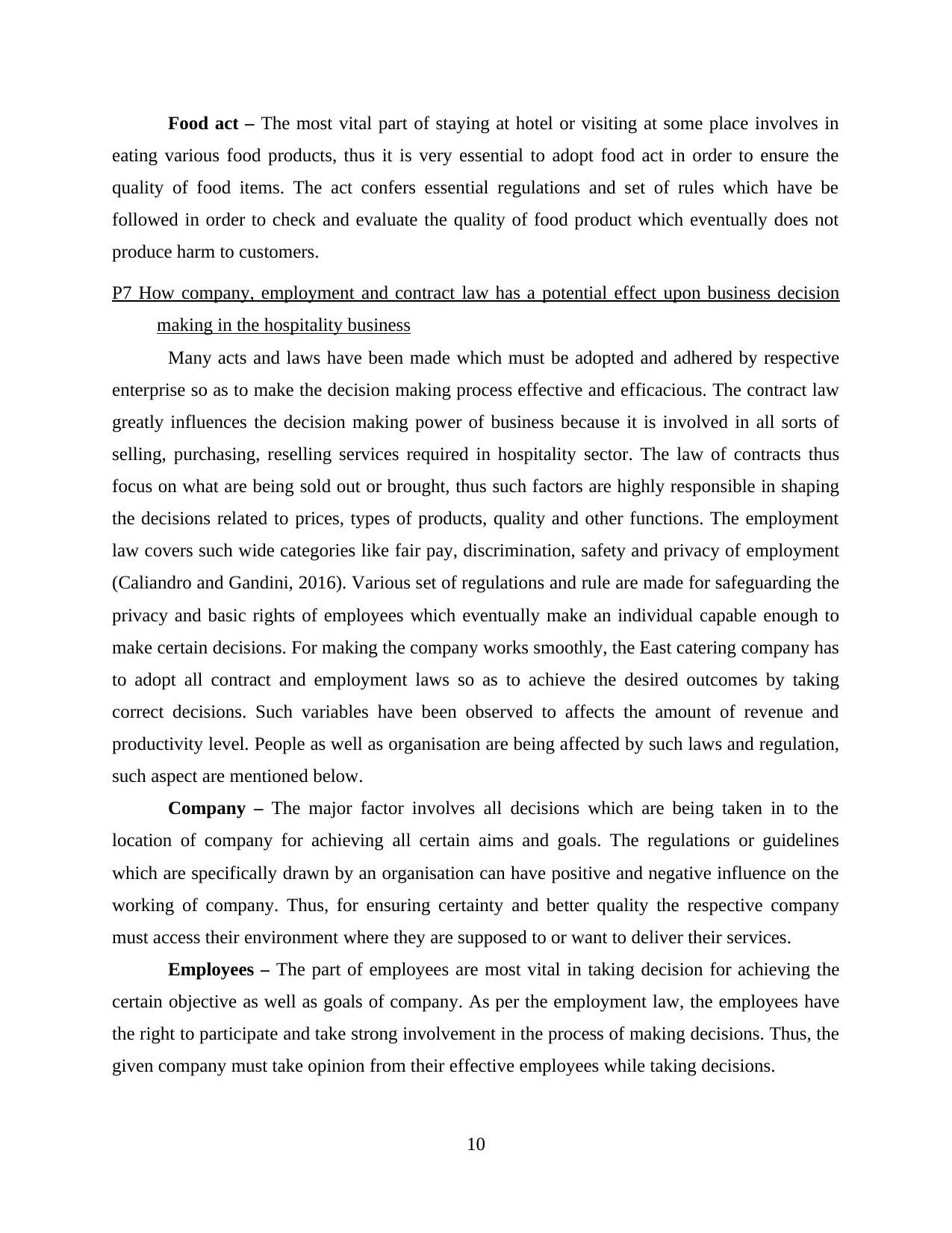
Food act – The most vital part of staying at hotel or visiting at some place involves in
eating various food products, thus it is very essential to adopt food act in order to ensure the
quality of food items. The act confers essential regulations and set of rules which have be
followed in order to check and evaluate the quality of food product which eventually does not
produce harm to customers.
P7 How company, employment and contract law has a potential effect upon business decision
making in the hospitality business
Many acts and laws have been made which must be adopted and adhered by respective
enterprise so as to make the decision making process effective and efficacious. The contract law
greatly influences the decision making power of business because it is involved in all sorts of
selling, purchasing, reselling services required in hospitality sector. The law of contracts thus
focus on what are being sold out or brought, thus such factors are highly responsible in shaping
the decisions related to prices, types of products, quality and other functions. The employment
law covers such wide categories like fair pay, discrimination, safety and privacy of employment
(Caliandro and Gandini, 2016). Various set of regulations and rule are made for safeguarding the
privacy and basic rights of employees which eventually make an individual capable enough to
make certain decisions. For making the company works smoothly, the East catering company has
to adopt all contract and employment laws so as to achieve the desired outcomes by taking
correct decisions. Such variables have been observed to affects the amount of revenue and
productivity level. People as well as organisation are being affected by such laws and regulation,
such aspect are mentioned below.
Company – The major factor involves all decisions which are being taken in to the
location of company for achieving all certain aims and goals. The regulations or guidelines
which are specifically drawn by an organisation can have positive and negative influence on the
working of company. Thus, for ensuring certainty and better quality the respective company
must access their environment where they are supposed to or want to deliver their services.
Employees – The part of employees are most vital in taking decision for achieving the
certain objective as well as goals of company. As per the employment law, the employees have
the right to participate and take strong involvement in the process of making decisions. Thus, the
given company must take opinion from their effective employees while taking decisions.
10
eating various food products, thus it is very essential to adopt food act in order to ensure the
quality of food items. The act confers essential regulations and set of rules which have be
followed in order to check and evaluate the quality of food product which eventually does not
produce harm to customers.
P7 How company, employment and contract law has a potential effect upon business decision
making in the hospitality business
Many acts and laws have been made which must be adopted and adhered by respective
enterprise so as to make the decision making process effective and efficacious. The contract law
greatly influences the decision making power of business because it is involved in all sorts of
selling, purchasing, reselling services required in hospitality sector. The law of contracts thus
focus on what are being sold out or brought, thus such factors are highly responsible in shaping
the decisions related to prices, types of products, quality and other functions. The employment
law covers such wide categories like fair pay, discrimination, safety and privacy of employment
(Caliandro and Gandini, 2016). Various set of regulations and rule are made for safeguarding the
privacy and basic rights of employees which eventually make an individual capable enough to
make certain decisions. For making the company works smoothly, the East catering company has
to adopt all contract and employment laws so as to achieve the desired outcomes by taking
correct decisions. Such variables have been observed to affects the amount of revenue and
productivity level. People as well as organisation are being affected by such laws and regulation,
such aspect are mentioned below.
Company – The major factor involves all decisions which are being taken in to the
location of company for achieving all certain aims and goals. The regulations or guidelines
which are specifically drawn by an organisation can have positive and negative influence on the
working of company. Thus, for ensuring certainty and better quality the respective company
must access their environment where they are supposed to or want to deliver their services.
Employees – The part of employees are most vital in taking decision for achieving the
certain objective as well as goals of company. As per the employment law, the employees have
the right to participate and take strong involvement in the process of making decisions. Thus, the
given company must take opinion from their effective employees while taking decisions.
10
Paraphrase This Document
Need a fresh take? Get an instant paraphrase of this document with our AI Paraphraser
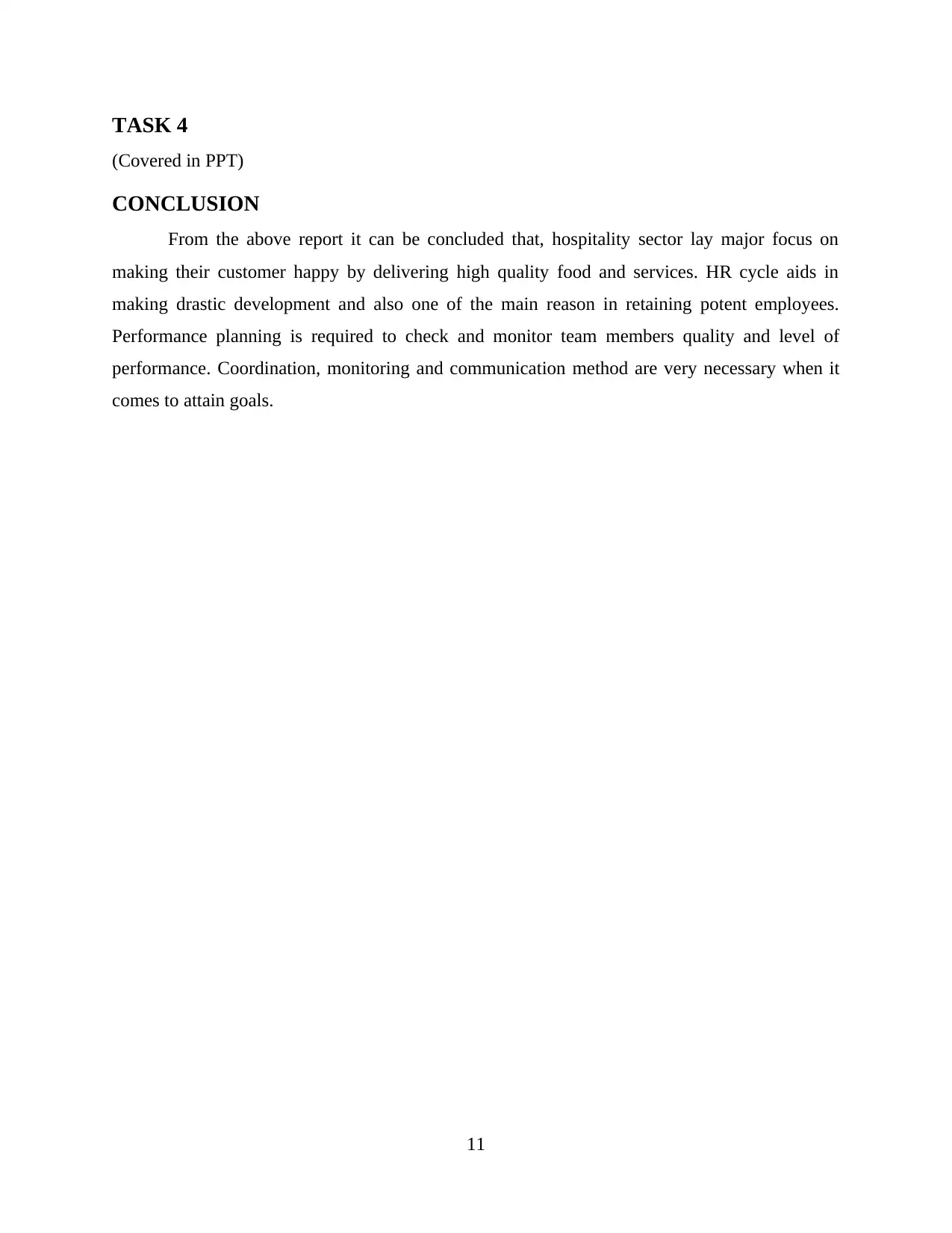
TASK 4
(Covered in PPT)
CONCLUSION
From the above report it can be concluded that, hospitality sector lay major focus on
making their customer happy by delivering high quality food and services. HR cycle aids in
making drastic development and also one of the main reason in retaining potent employees.
Performance planning is required to check and monitor team members quality and level of
performance. Coordination, monitoring and communication method are very necessary when it
comes to attain goals.
11
(Covered in PPT)
CONCLUSION
From the above report it can be concluded that, hospitality sector lay major focus on
making their customer happy by delivering high quality food and services. HR cycle aids in
making drastic development and also one of the main reason in retaining potent employees.
Performance planning is required to check and monitor team members quality and level of
performance. Coordination, monitoring and communication method are very necessary when it
comes to attain goals.
11
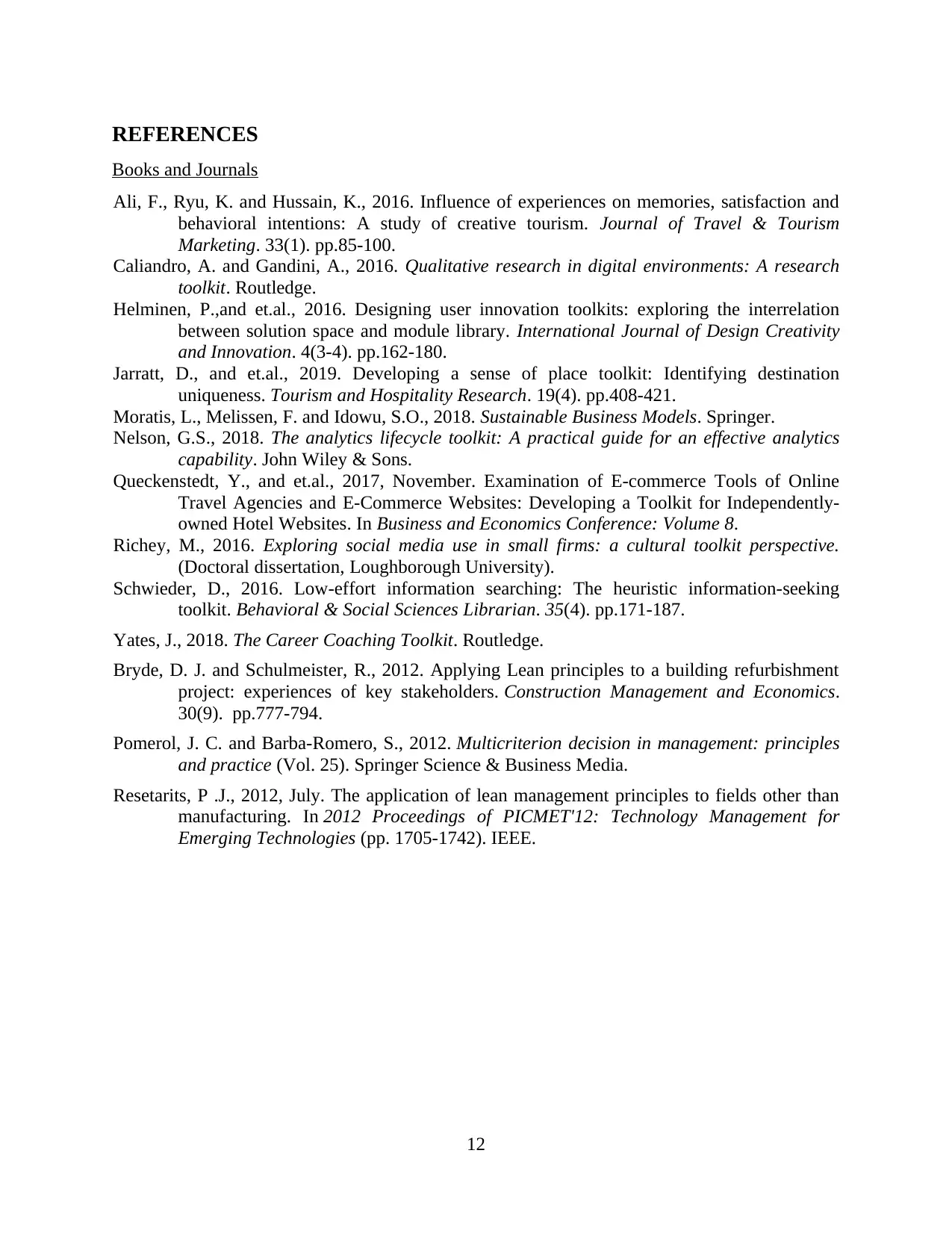
REFERENCES
Books and Journals
Ali, F., Ryu, K. and Hussain, K., 2016. Influence of experiences on memories, satisfaction and
behavioral intentions: A study of creative tourism. Journal of Travel & Tourism
Marketing. 33(1). pp.85-100.
Caliandro, A. and Gandini, A., 2016. Qualitative research in digital environments: A research
toolkit. Routledge.
Helminen, P.,and et.al., 2016. Designing user innovation toolkits: exploring the interrelation
between solution space and module library. International Journal of Design Creativity
and Innovation. 4(3-4). pp.162-180.
Jarratt, D., and et.al., 2019. Developing a sense of place toolkit: Identifying destination
uniqueness. Tourism and Hospitality Research. 19(4). pp.408-421.
Moratis, L., Melissen, F. and Idowu, S.O., 2018. Sustainable Business Models. Springer.
Nelson, G.S., 2018. The analytics lifecycle toolkit: A practical guide for an effective analytics
capability. John Wiley & Sons.
Queckenstedt, Y., and et.al., 2017, November. Examination of E-commerce Tools of Online
Travel Agencies and E-Commerce Websites: Developing a Toolkit for Independently-
owned Hotel Websites. In Business and Economics Conference: Volume 8.
Richey, M., 2016. Exploring social media use in small firms: a cultural toolkit perspective.
(Doctoral dissertation, Loughborough University).
Schwieder, D., 2016. Low-effort information searching: The heuristic information-seeking
toolkit. Behavioral & Social Sciences Librarian. 35(4). pp.171-187.
Yates, J., 2018. The Career Coaching Toolkit. Routledge.
Bryde, D. J. and Schulmeister, R., 2012. Applying Lean principles to a building refurbishment
project: experiences of key stakeholders. Construction Management and Economics.
30(9). pp.777-794.
Pomerol, J. C. and Barba-Romero, S., 2012. Multicriterion decision in management: principles
and practice (Vol. 25). Springer Science & Business Media.
Resetarits, P .J., 2012, July. The application of lean management principles to fields other than
manufacturing. In 2012 Proceedings of PICMET'12: Technology Management for
Emerging Technologies (pp. 1705-1742). IEEE.
12
Books and Journals
Ali, F., Ryu, K. and Hussain, K., 2016. Influence of experiences on memories, satisfaction and
behavioral intentions: A study of creative tourism. Journal of Travel & Tourism
Marketing. 33(1). pp.85-100.
Caliandro, A. and Gandini, A., 2016. Qualitative research in digital environments: A research
toolkit. Routledge.
Helminen, P.,and et.al., 2016. Designing user innovation toolkits: exploring the interrelation
between solution space and module library. International Journal of Design Creativity
and Innovation. 4(3-4). pp.162-180.
Jarratt, D., and et.al., 2019. Developing a sense of place toolkit: Identifying destination
uniqueness. Tourism and Hospitality Research. 19(4). pp.408-421.
Moratis, L., Melissen, F. and Idowu, S.O., 2018. Sustainable Business Models. Springer.
Nelson, G.S., 2018. The analytics lifecycle toolkit: A practical guide for an effective analytics
capability. John Wiley & Sons.
Queckenstedt, Y., and et.al., 2017, November. Examination of E-commerce Tools of Online
Travel Agencies and E-Commerce Websites: Developing a Toolkit for Independently-
owned Hotel Websites. In Business and Economics Conference: Volume 8.
Richey, M., 2016. Exploring social media use in small firms: a cultural toolkit perspective.
(Doctoral dissertation, Loughborough University).
Schwieder, D., 2016. Low-effort information searching: The heuristic information-seeking
toolkit. Behavioral & Social Sciences Librarian. 35(4). pp.171-187.
Yates, J., 2018. The Career Coaching Toolkit. Routledge.
Bryde, D. J. and Schulmeister, R., 2012. Applying Lean principles to a building refurbishment
project: experiences of key stakeholders. Construction Management and Economics.
30(9). pp.777-794.
Pomerol, J. C. and Barba-Romero, S., 2012. Multicriterion decision in management: principles
and practice (Vol. 25). Springer Science & Business Media.
Resetarits, P .J., 2012, July. The application of lean management principles to fields other than
manufacturing. In 2012 Proceedings of PICMET'12: Technology Management for
Emerging Technologies (pp. 1705-1742). IEEE.
12
⊘ This is a preview!⊘
Do you want full access?
Subscribe today to unlock all pages.

Trusted by 1+ million students worldwide
1 out of 12
Related Documents
Your All-in-One AI-Powered Toolkit for Academic Success.
+13062052269
info@desklib.com
Available 24*7 on WhatsApp / Email
![[object Object]](/_next/static/media/star-bottom.7253800d.svg)
Unlock your academic potential
Copyright © 2020–2025 A2Z Services. All Rights Reserved. Developed and managed by ZUCOL.





